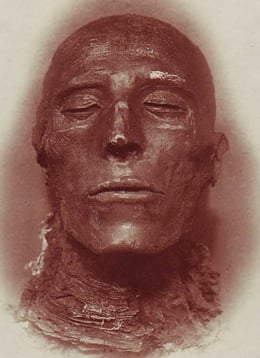I had heard about this before. That mummies were used to make paper but this is the first time I'm seeing something more concrete. If this was done, then it's shocking no? In rider haggard 'a She, mummified bodies were used as torches! Life imitating art eh?
Curious
Hope you're having fun with your friends Kannu
And best of luck with the exam today Diya.
Love
Baba
The Mystery of Mummy Paper
http://blog.bookstellyouwhy.com/the-mystery-of-mummy-paper
(via Instapaper)
Paper. We grab a scrap to jot down a phone number, we see movie posters, exchange greeting cards, hold paper books in our hands. We come in contact with so much paper, it's hard to keep track, and this is during a so-called "digital age" when we should be immersed in a nearly paperless world. And yet, it continues to be necessary, wanted, and part of the fabric of our routines and desires.
Imagine now, a world in which we need paper even more, for nearly everything. From communication to profit, paper is necessary. It's basically the internet of the day, and the civilized world finds itself in desperate need and facing a real shortage. Enter: Mummy Paper!
 Mummy Paper is the stuff of legends, much like the mummies it was supposedly torn from. American paper, made from cotton and linen rag fiber, became in short supply due to the huge newspaper boom. The rags, imported from Europe for the most part, were not sufficient to feed the newspaper industry properly.
Mummy Paper is the stuff of legends, much like the mummies it was supposedly torn from. American paper, made from cotton and linen rag fiber, became in short supply due to the huge newspaper boom. The rags, imported from Europe for the most part, were not sufficient to feed the newspaper industry properly.
The man on a mission to save the newspaper industry and locate a new source for linen rags was Dr. Isaiah Deck, who was a geologist, archeologist, and explorer. Visiting Egypt on another task, he discovered "Mummy pits" which were large burial sites full of mummies and parts of mummies, all wrapped in linen. He crunched some numbers and reasoned that there must be at least five hundred million mummies in and around Egypt, and the amount of linen they might provide would be substantial.
This is where fact and fiction part ways, and no one can truly tell what did or did not happen with any amount of certainty.
There are some specific primary sources that give the idea of importing and using mummy rags to make paper some credibility. Daniel Stanwood, son of I. Augustus Stanwood, communicates that his father told stories of importing mummies from Egypt and using the wrappings to make paper in his mills. There is also a letter from a Mrs. John Ramsey who had a father, who had a friend, who remembered unrolling the mummies, and that the "cocoon" used to resemble the human form, even after it had been stripped away, because it had been in that shape for so long.
Curious
Hope you're having fun with your friends Kannu
And best of luck with the exam today Diya.
Love
Baba
The Mystery of Mummy Paper
http://blog.bookstellyouwhy.com/the-mystery-of-mummy-paper
(via Instapaper)
Paper. We grab a scrap to jot down a phone number, we see movie posters, exchange greeting cards, hold paper books in our hands. We come in contact with so much paper, it's hard to keep track, and this is during a so-called "digital age" when we should be immersed in a nearly paperless world. And yet, it continues to be necessary, wanted, and part of the fabric of our routines and desires.
Imagine now, a world in which we need paper even more, for nearly everything. From communication to profit, paper is necessary. It's basically the internet of the day, and the civilized world finds itself in desperate need and facing a real shortage. Enter: Mummy Paper!
 Mummy Paper is the stuff of legends, much like the mummies it was supposedly torn from. American paper, made from cotton and linen rag fiber, became in short supply due to the huge newspaper boom. The rags, imported from Europe for the most part, were not sufficient to feed the newspaper industry properly.
Mummy Paper is the stuff of legends, much like the mummies it was supposedly torn from. American paper, made from cotton and linen rag fiber, became in short supply due to the huge newspaper boom. The rags, imported from Europe for the most part, were not sufficient to feed the newspaper industry properly.The man on a mission to save the newspaper industry and locate a new source for linen rags was Dr. Isaiah Deck, who was a geologist, archeologist, and explorer. Visiting Egypt on another task, he discovered "Mummy pits" which were large burial sites full of mummies and parts of mummies, all wrapped in linen. He crunched some numbers and reasoned that there must be at least five hundred million mummies in and around Egypt, and the amount of linen they might provide would be substantial.
This is where fact and fiction part ways, and no one can truly tell what did or did not happen with any amount of certainty.
There are some specific primary sources that give the idea of importing and using mummy rags to make paper some credibility. Daniel Stanwood, son of I. Augustus Stanwood, communicates that his father told stories of importing mummies from Egypt and using the wrappings to make paper in his mills. There is also a letter from a Mrs. John Ramsey who had a father, who had a friend, who remembered unrolling the mummies, and that the "cocoon" used to resemble the human form, even after it had been stripped away, because it had been in that shape for so long.
No comments:
Post a Comment